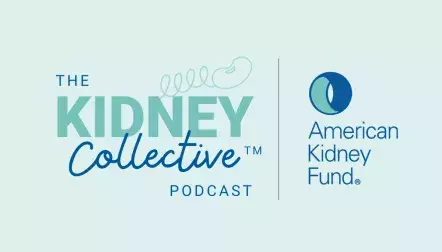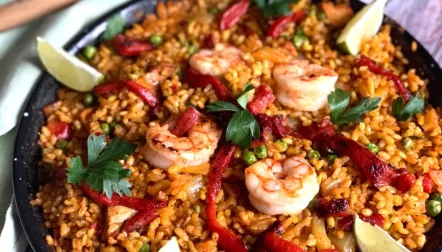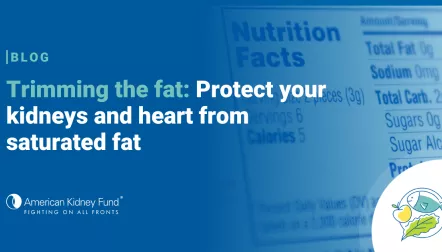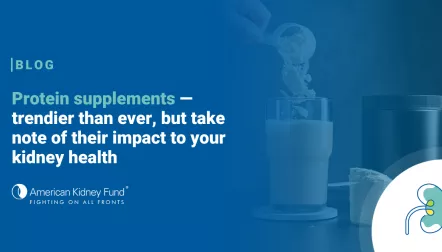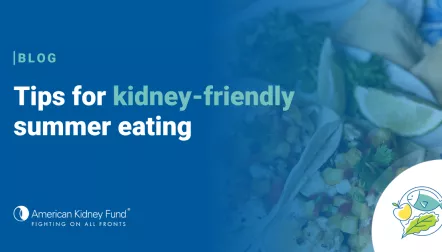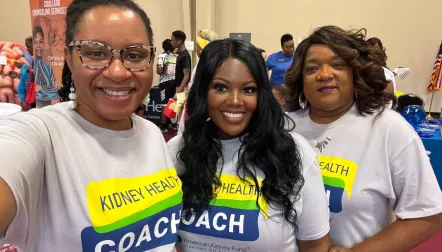
Blog post
7 keys to success with a kidney-friendly meal plan

Having to follow a kidney-friendly food and fluid plan can be overwhelming! Whether you have just received a new diagnosis, or it has been years, we are here to help you find solutions for the obstacles in your way. Let us take the stress and worry out of kidney-friendly eating, one step at a time.
Our culinary specialty is centered around food allergies, special dietary requirements, celiac disease and chronic diseases. As chefs at Walt Disney World Resorts, our interaction with thousands of guests with special dietary requirements gives us a unique perspective on people's needs. We truly understand — Mary lives with an autoimmune disease and cannot have gluten, soy, dairy, corn or canola.
Here are seven keys that we have learned can help overcome the challenges of kidney-friendly eating:
1. Educate your friends and family
Learn as much as you can to educate yourself, your family and your friends about your kidney-friendly food and fluid needs. Let your family and friends know that you are grateful for their awareness and understanding and that you hope they know that you would do the same for them.
2. Set up a healthy kitchen
A healthy kitchen is a safe and clean kitchen with an organized pantry. Bonus: organized kitchens make cooking more fun!
Review all food products in your kitchen. Look carefully at ingredient labels to identify and discard foods you need to avoid. You can donate them to a local food bank or give them to a neighbor so they do not go to waste.
Check nutrition labels on your condiments, too. Discard any that have expired, or have high amounts of sugar, salt and/or potassium.
Organize your fridge weekly. Every three to four months, take everything out and give it a deep cleaning.
3. Plan your meals
Menu planning is a great way to make sure you are sticking to the kidney-friendly food and fluid plan you have discussed with your doctor and dietitian. Plus, you can have a big effect on your health and your budget by eating at home more often.
Taking time to plan meals means less impulse shopping, which often results in grabbing unhealthy options. Plan meals that everyone can enjoy, so you do not feel singled out by having to have a special or separate dish. There are so many wonderful kidney-friendly foods that everyone can enjoy.
On busy days, plan to make easy recipes, like ones that can be made in a slow cooker. Plan a week of meals at a time and hold on to your menu plan to reuse later. You can designate certain foods for different days of the week. For example, designate Mondays as pasta nights and Fridays as chicken nights. For inspiration on menu ideas, check out Kidney Kitchen®'s library of over 600 recipes.
Portion control is important! To control portions, use small plates to trick your brain into seeing an overflowing, full plate.
4. Learn your labels
Carefully reading and interpreting food labels is key to ensuring that you make safe and healthy food choices. The nutritional information found on a food label is based on one serving of that particular food. Always look at what makes one serving and how many servings the package contains.
Food labels also include exactly what is in the package. The first ingredient in the list of ingredients represents the ingredient with the largest amount. The second ingredient is the second highest amount, and so on.
Sodium is hidden in many ingredients and has many names other than salt. Many sources of sodium include the word sodium, so be aware of these ingredients. A few examples are monosodium glutamate (MSG), sodium benzoate and sodium nitrite. Processed and prepared foods are often high in sodium.
Sugar can also be listed on food labels as corn syrup, high-fructose corn syrup, dehydrated cane juice and agave nectar, just to name a few.
Since phosphorus is often missing from nutrition labels, it is important to know how to find hidden sources of phosphorus in ingredient lists. One not-so-obvious source of phosphorus is baking powder. Also look for terms like polyphosphate, phosphoric acid and calcium phosphate. Avoid those products.
Potassium chloride is sometimes added to "low-salt" and "low-sodium" foods. Check food labels carefully for ingredients that have potassium in their name. The liquid in canned fruits and vegetables has sodium and potassium, so be sure to rinse and drain them well before eating.
5. Eating out? Call ahead
After choosing a restaurant, call ahead and ask to speak with a manager. When you talk with the manager, make sure they understand the severity of your kidney-friendly dietary requirements. Ask if you may review their recipe book or ingredient list. A recipe book is common in most, if not all, kitchens. Be on the alert for hidden ingredients.
Tip: Call the restaurant during slow or non-meal times so the manager can give you their full attention.
6. Join a support group
Support groups can be an important source of encouragement and information. Talking to other people living with kidney disease can be a much-needed opportunity to vent, share, receive — and provide — support. Talk to your doctor about any groups or organizations they may know of.
7. Kidney-friendly eating is a lifestyle
Think about your kidney-friendly eating as a lifestyle, not a "diet." Our brains often associate diets with deprivation. You will not be deprived. Focusing on the foods you can eat, rather than the ones you cannot, will help to make your journey a positive experience. It may seem like a struggle to manage specific nutrients in your foods and drinks, but eating and drinking more of what is good for you makes it easier to cut back on the foods that are not.
